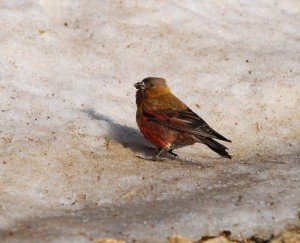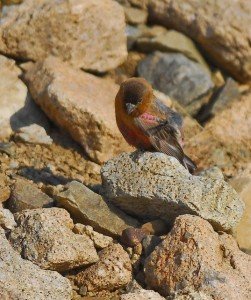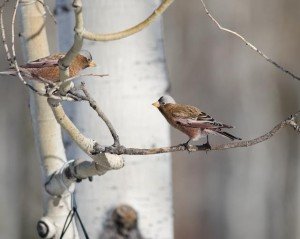I think we can all readily admit that when summer comes, nature just seems to burst out at the seams. It is this season we experience vast musical repertoires, green canopies, hot air, and bustling energy. Now, here in Colorado this is the season for the high-country birds. The grasslands have been popping off with breeders for well over a month, but the snow is just now giving way to lush alpine meadows and rocky tundras. This is my time of year to explore thin air and look for unique Colorado breeders. The trails will be packed with weekend warriors, but being a birder means I get to get up earlier than all of them and get ahead of the pack. One of the birds I will focus on this summer is one of my favorites even though they can be difficult to reach. The Brown-capped Rosy-Finch is often the type of bird birders find at high-elevation feeders in the winter which helps save the sometimes excruciating effort to get them in summer. But hey, how fun is that?
This larger finch can be found in summer feeding on the edge of snow fields usually above 11,400 feet, which is timberline here in Colorado. When viewed like this they are looking for any seeds and grasses and will also chance upon on a few insects for a meal. These birds capitalize on a quick breeding season and usually have young out by mid-July in most cases. The young of which look like LBJs otherwise known as “little brown jobs.” They are thicker-bodied than some common finches we know (i.e., Pine Siskin), but still show the slightly cleft tail that all finches show along with a large conical, dark bill. The adults have a contrasting brown/dark cap, rusty mantle and breast, but the bright PINK flanks/belly and some of the flight feathers are what really stands out. That is to say if you’ve gotten close enough. Try hiking a Colorado 14,000 foot mountain and your chances of having these guys at your feet rise exponentially.
Most REAL montane species like this finch are declining in overall population. Their range of breeding is literally only very southern Wyoming to very northern New Mexico. Thus, Colorado encapsulates most of their breeding range. Having said that, Colorado has done a wonderful job of protecting habitat and since this species breeds on super high cliffs there is no true threat to habitat destruction. Furthermore, our stage of climatic shift along with our rapidly global temperature rise has sped up the process of habitat change. The Alpine Tundra seems to be shrinking and that will be the demise of this species along with a few others in the historic future to come.
Brown-caps are elevational migrants meaning they move to lower elevations in winter to find the appropriate food source. This, however, is all snow dependent and if there is food up high than they will stay up there. High elevations feeders are what are so sought-after by birders in the winter. All three species of rosy-finch along with the “Hepburn’s” race of the Gray-crowned Rosy-Finch can occur at these feeders.
These Gray-crowned Rosy-Finches were photographed on the North Park CBC a couple years ago and they were literally accompanied by 150 more of their close-cousins (so-to-speak). There were no Black Rosy-Finches during that day, but usually that is the most uncommon species of the three. Nevertheless, they do winter in Colorado as well.
So when traveling Colorado and in the high-country keep an eye out for rosy-finches flying over head. They have a very full-noted call that sounds like a “Choo.” They will undoubtedly be flying in small groups so expect to hear a few of those together in succession. Keep in mind that as they are flying overhead look for the larger finch-like body and short, cleft tail. That will be the easiest way to ID them. If you find a snow pack in the middle of the summer just sit down and be patient. Most often, patience is rewarded with views within a few feet of your position. JUST BE PATIENT! These are fairly social birds if the area’s activity level is low.
There is nothing like waiting for these birds to show up at 12,500 feet with vistas that rival the Himalayas. Of course, if you’re like me and you’re hiking up there I am sure that by that time one might need the break. By the time I climb that high my shirt is usually soaked and my lungs burnt, so breaks are always called for.
Thanks for reading and I really hope you all can make it to Colorado to experience the best breeding birds in the United States! Cheers and Good Birding!














Very interesting to see these finches. We have a few here but nothing like those Gray-crowned Rosy-Finches.
Dear Colleague,
I liked much your paper and I am much interested by Finches. I have published 11 monographs on Finches and now updating a commented bibliography on Finches. Same amounts to about 11,000 intries and about 300 papers have to be included; Professor A.A. Dhont, from Cornell Univ. knows me much for I was his pupil when I ringed birds on Belgium. Every paper dealing with finches is welcome. I may send you freely all my papers located on my website. Yours truly. Kind regards. Marcel Ruelle